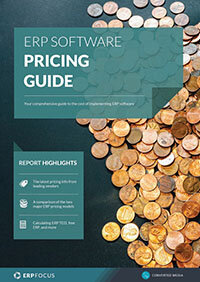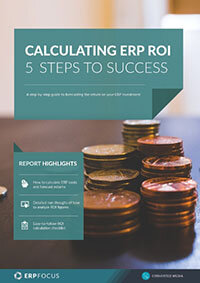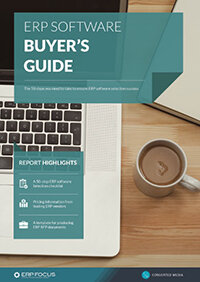Critical cost considerations in ERP TCO calculations
To gain a real understanding of what total cost of ownership (TCO) in an ERP implementation really means, the divination of ‘true’ cost, demands much more than simply identifying and collecting long lists of numbers. To give you a general sense, most business analysts, such as Investopedia, define TCO as “…the purchase price of an asset plus the costs of operation.”
While this definition is a clearly elegant way to deliver a short answer to a long question, at a practical level, there are hosts of direct, indirect, in-the-middle, and real-world business questions that may, or may not, apply to a projected total cost of ownership. For example, what likely cost impacts may emerge during an ERP implementation during its initial enterprise introduction; how implementation cost projections can be skewed by known and/or unknown workforce-related events; and/or what cost implications may accrue to an enterprises’ initial technical stability.
Then, if these variables aren’t enough to worry about, other more atypical elements can also apply, such as cost impacts relating to weaknesses in the baseline financial strength of a specific enterprise; or costs that may apply to a sudden, ad-hoc need for additional third-party services support. Consequently, we thought we’d take a look at the premise of TCO from a slightly hybridized view of things, rather than a purely ‘by the book’ approach.
To be sure, this article will still be as subjective as any other discussion model built by a human for humans, based on practical experience. Nevertheless, the effort will hopefully expand your thinking beyond the ‘box’ that most enterprise cost-accountants typically operate in, while also allowing the reader to identify and establish a couple of new competitive cost advantages here and there.
What is the total cost of ownership (TCO) in an ERP implementation?
However, before we can get to a hybridized total cost of ownership formula, it’s best to go back and review the tried and true first. So, let’s take a look at the areas of focus that most typically apply to a formal TCO analysis. According to the Business Dictionary, total cost calculations for computing systems include; “total of direct capital investment in hardware and software plus indirect costs of installation, training, repairs, downtime, technical support, and upgrading; also called cost of ownership or ownership cost.”
In practical terms, this means how much money will be required to complete an ERP implementation based on what an enterprise ‘should’ be able to identify, before taking the risk. While this is all well and good as a paper exercise, again as we pointed out earlier, those elements may not necessarily apply in the real world, so let's take a look at both the typical and the unconventional factors that impact your ERP TCO and see what we get in the end.
Growth capital costs
This TCO element is typically defined by significant costs oriented to mounting a particular business growth effort. In our ERP scenario that cost could be measured by a company’s initial cash out-of-pocket, or projected all-in costs relating to a third-party financing agency, i.e. commercial bank, capital equity, private equity or venture capital investor etc. In these latter cases, measured costs can include principal, interest, potential payoff penalties, and/or equity/share costs over time, and may, or may not, apply directly to the company’s specific P/L.
Finally, before we leave issues related to capital, there is another rarely considered cost element related to TCO. This relates to the matter of ‘opportunity cost’, or “…benefits a business misses when choosing one alternative (product) over another.” Regardless, of a final ERP selection decision, business costs are still incurred during researching, investigating and ultimately discarding one or more competing brands.
Consequently, win or lose, if a company really intends to understand its costs relating to an ERP implementation; all costs must apply. Otherwise, there’s a fair chance that one or more hidden cost can lurk within its financial framework that could cause a problem somewhere down the road.
Software costs
As one might expect this element is essentially driven by the cost of the core ERP platform. However, when it comes to issues relating to the total cost of ownership of software, other secondary or tertiary costs can also apply. Some of these elements include; operational security, and/or low-level utilities; custom build systems that support the primary ERP system directly and/or in-directly; plus necessary software systems that apply to third-party development.
In some cases, core systems are further supported by training and educational applications that serve as frameworks for remedial, and/or on-going training programs; along with pure support platforms that relate to workforce communications systems and others. In this latter case, augmented reality systems, digital-to-shop-floor worker utilities, and production monitoring systems can apply.
The final total cost of ownership in procurement, then, can apply to everything a company can project at a software level, just as long as it applies directly to the ERP implementation cost.
Implementation costs
Next, as we begin to create our total cost of ownership calculator, we must also consider what implementation costs apply. In traditional terms, this usually means third-party costs relating to consultants, and/or a support staff that physically executes the spin up a particular ERP platform.
While this ‘Plain Jane’ definition is accurate enough, other less obvious costs also apply, including what can be referred to as ‘disruption costs.’ In the same way that our earlier discussion applied to opportunity costs, disruption costs exist similarly to costs that are rarely accounted for.
For example, consider lost worker time in the midst of an ERP implementation. Granted, in shop production terms, lost time can usually be accounted for as ‘float’. However, if time is lost waiting for a third-party consultant to resolve a platform problem before a training session can be launched, this cost is rarely accounted for, and instead is typically consumed as part of a particular companies fulltime employee cost schedule (FTE).
Again, this may be an easy enough fix. But in order to understand the TCO of a particular ERP implementation, disruption costs should be identified discretely, and accounted for individually, since each cost relates specifically to activities related to the ERP effort, not FTE costs at-large.
People costs
Perhaps the most costly of all TCO elements when executing an ERP implementation cost breakdown involves the cost of people. There are hosts of reasons for this, but the short of it involves the subjective behavior of a workforce in relation to its management team, and/or how each individual group responds to change during an implementation.
It is largely accepted that efficient team-building is one of the most difficult things to do when launching an ERP spin up in real-time, and more times than not, the result fails to measure up for one reason or another. Regardless of the cause(s), at-large workforce costs must still be projected, identified and accounted for throughout in order for a business to accurately assess a TCO; otherwise similar to hidden cost failures at a capital funding level, bad things can happen to a business’ bottom-line downstream.
‘Rainy day’ margin
This element is another unconventional cost that is rarely accounted for once all the accounting is allegedly complete, but nevertheless should be seen as a critical part of any ERP implementation TCO. Consider for a moment what cost impacts typically apply if a major mistake or system failure occurs during an active implementation.
Assuming that a company has budgeted properly, cost projections should be largely understood and expected. However, financial folks typically being who they are, resultant budgets are also likely to be empirically defined on the basis of on the best cases only. Consequently, then, if something really goes wrong, even the world’s best cost calculations won’t be able to avoid blowing a company’s final TCO into the weeds, unless a ‘rainy day’ margin element is included during its baseline ERP project cost estimation deliberations.
Upgrades
Although there are a number of other elements that apply to a proper ERP implementation TCO, one of the biggest calculations involves the cost of software upgrades. Many SaaS providers bundle the cost of recurrent upgrades with subscription costs which may or may not necessarily be understood by a company. Consequently, either this cost component should be clearly understood as being a discrete cost, or the ultimate brand provider should do so when purchase costs are itemized at the point of purchase.
Once again, this potential is another gotcha that can cause problems downstream if a company is not clued up enough to understand its TCO framework. So, as the old saying suggests; let the buyer beware lest you find yourself with a sudden cost that you can’t handle later.
Although this discussion represents only a sample of what a complete TCO exercise really entails from beginning to end, you should be able to get a sense of where you’ll need to go forward. As a rule of thumb, just remember that ‘more is better’ when working on any projected TCO calculation, while at the same time leaving yourself plenty of room to work with.
Free white paper

ERP Software Pricing Guide
Get the latest pricing information on over 80 popular ERP systems, and learn how to budget for your ERP project in our free guide

Featured white papers
-

ERP Software Pricing Guide
Get the latest pricing information on over 80 popular ERP systems, and learn how to budget for your ERP project in our free guide
Download -

Calculating ERP ROI: 5 steps to success
Calculate your new ERP's financial benefits with this comprehensive guide
Download -

ERP software buyer's guide
Save hours of ERP selection research with this comprehensive buyer's guide
Download
Related articles
-

28 cost elements to include in your ERP TCO calculation
With differing definitions and more hidden costs than you can shake a stick at, ERP TCO can be a ...
-

CMMC Compliance: What Aerospace and Defense Manufacturers Need to Know
Key insights on CMMC compliance, deadlines, and securing DoD contracts with CMMC 2.0 certificatio...
-

Top ERP systems for small businesses
Which ERP solutions are best for small business needs? Information on features, scalability and m...

